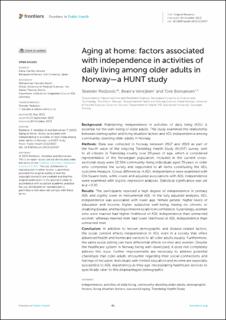| dc.contributor.author | Redzovic, Skender Elez | |
| dc.contributor.author | Vereijken, Beatrix | |
| dc.contributor.author | Bonsaksen, Tore | |
| dc.coverage.spatial | Norway | en_US |
| dc.date.accessioned | 2023-10-18T12:14:37Z | |
| dc.date.available | 2023-10-18T12:14:37Z | |
| dc.date.created | 2023-10-05T09:22:14Z | |
| dc.date.issued | 2023-10-04 | |
| dc.identifier.citation | Frontiers in Public Health. 2023, . | en_US |
| dc.identifier.issn | 2296-2565 | |
| dc.identifier.uri | https://hdl.handle.net/11250/3097285 | |
| dc.description.abstract | Background: Maintaining independence in activities of daily living (ADL) is essential for the well-being of older adults. This study examined the relationship between demographic and living situation factors and ADL independence among community-dwelling older adults in Norway. Methods: Data was collected in Norway between 2017 and 2019 as part of the fourth wave of the ongoing Trøndelag Health Study (HUNT) survey, sent to all citizens in Trøndelag county over 20 years of age, which is considered representative of the Norwegian population. Included in the current crosssectional study were 22,504 community-living individuals aged 70 years or older who completed the survey and responded to all items constituting the ADL outcome measure. Group differences in ADL independence were examined with Chi Square tests, while crude and adjusted associations with ADL independence were examined with logistic regression analyses. Statistical significance was set at p < 0.05. Results: The participants reported a high degree of independence in primary ADL and slightly lower in instrumental ADL. In the fully adjusted analyses, ADL independence was associated with lower age, female gender, higher levels of
education and income, higher subjective well-being, having no chronic or disabling disease, and having someone to talk to in confidence. Surprisingly, women who were married had higher likelihood of ADL independence than unmarried women, whereas married men had lower likelihood of ADL independence than unmarried men. Conclusion: In addition to known demographic and disease-related factors, the social context affects independence in ADL even in a society that offers advanced health and homecare services to all older adults equally. Furthermore, the same social setting can have differential effects on men and women. Despite the healthcare system in Norway being well-developed, it does not completely address this issue. Further improvements are necessary to address potential challenges that older adults encounter regarding their social connections and feelings of inclusion. Individuals with limited education and income are especially susceptible to ADL dependency as they age, necessitating healthcare services to specifically cater to this disadvantaged demographic. | en_US |
| dc.language.iso | eng | en_US |
| dc.rights | Navngivelse 4.0 Internasjonal | * |
| dc.rights.uri | http://creativecommons.org/licenses/by/4.0/deed.no | * |
| dc.subject | independence | en_US |
| dc.subject | activities of daily living | en_US |
| dc.subject | community-dwelling older adults | en_US |
| dc.subject | demographic factors | en_US |
| dc.subject | living situation factors | en_US |
| dc.subject | successful aging | en_US |
| dc.subject | Trøndelag Health Study | en_US |
| dc.title | Aging at home: factors associated with independence in activities of daily living among older adults in Norway—a HUNT study | en_US |
| dc.title.alternative | Aging at home: factors associated with independence in activities of daily living among older adults in Norway—a HUNT study | en_US |
| dc.type | Peer reviewed | en_US |
| dc.type | Journal article | en_US |
| dc.description.version | publishedVersion | en_US |
| dc.subject.nsi | VDP::Medisinske Fag: 700::Helsefag: 800 | en_US |
| dc.source.pagenumber | 9 | en_US |
| dc.source.volume | 11 | en_US |
| dc.source.journal | Frontiers in Public Health | en_US |
| dc.identifier.doi | 10.3389/fpubh.2023.1215417 | |
| dc.identifier.cristin | 2181892 | |
| cristin.ispublished | true | |
| cristin.fulltext | original | |
| cristin.qualitycode | 1 | |

